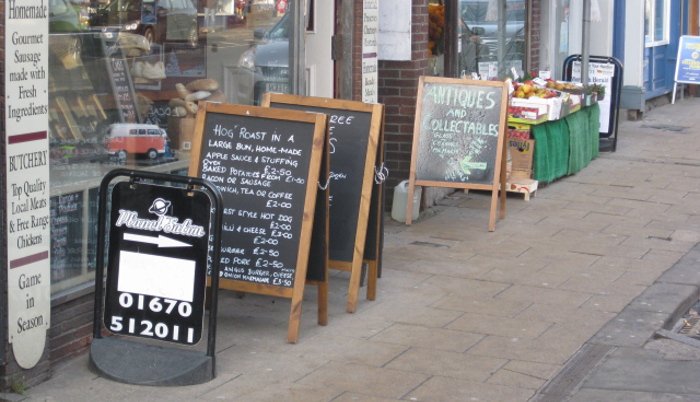How you can make our streets accessible for everyone
At the RNIB, we advocate for the creation of inclusive environments that enable people with sight loss to navigate their surroundings independently and safely. Making our streets accessible for everyone is not only a matter of convenience but also a fundamental right. In this guide, you will find out what you can do to support people with sight loss in your neighbourhood and make our streets accessible to everyone. But first, a look at the barriers to blind and partially sighted people getting out and about highlighted by RNIB's "Who put that there" survey findings.
Who put that there!
Challenges faced by people with sight loss in our streets
Bins and rubbish bags
Obstructions that block pavements have a far greater impact on blind and partially sighted people than they do for other sections of the community. Each and every wheelie bin, rubbish bag or container that obstructs a pavement increases the risk of accidents and injury. They are a trip hazard and where hard surfaces come into sharp contact with skin, they can lead to physical injuries.
To help people with sight loss in your neighbourhood, ensure any bins you put out aren't blocking the pavement on collection day and don't leave them out for any longer than necessary.

Judith trying to navigate around poorly placed wheelie bins with her white cane.
Overgrown shrubbery stretching over a pavement on a residential street.
Hitting your head on an overhanging branch or walking into overgrown shrubbery can be a real problem for blind and partially sighted pedestrians, especially during the summer months. Each and every overhanging branch or overgrown shrub that obstructs a pavement can be a huge risk for blind and partially sighted people. They can lead to physical injuries which can put people off getting out and about in their areas.
You can help people with sight loss in your community massively by making sure any overgrown branches or shrubs are trimmed back and not obstructing pavements and public footpaths. Learn more about how to do this below.

Overgrown shrubbery stretching over a pavement on a residential street.
Pavement parking
Clear pavements are essential for blind and partially sighted people, however, most report parking on pavements as a regular problem which impacts their ability to get around.
Drivers often mistakenly think they are doing the right thing by keeping the road clear, but fail to realise the consequences of their vehicle now blocking the footpath. The impact is that people with sight loss cannot see the obstruction until it is too late, colliding with the parked vehicle. As a driver, you can help by simply avoiding parking on the pavement where possible.

A large van parked on the pavement, blocking most of the path for pedestrians.
Pavement signs and a-boards
A-boards and other pavement signs obstruct pedestrians from being able to move in a straight line along the pavement. They present a trip and collision hazard, especially for people with sight loss who cannot see them and who use mobility aids.
These signs are used by businesses and other organisations to position advertising messages at pavement level. Typically, a simple stand-alone board on a heavy 'A' shape frame, they are placed across the pavement and in the way of people, in order to attract their attention.

A row of shops along a street, all with pavement signs and advertising boards in front of them.
Pedestrian crossings
For blind and partially sighted people, safe crossing points are a vital component in the negotiation of their local communities.
Crossing the street is an essential part of negotiating our built environment. The quality, provision or absence of crossing points affect people’s ability and desire to both get around and use their local streets safely.
If crossing the street is difficult, dangerous, or involves walking further than necessary, you may simply find yourself choosing not to make the journey or take unnecessary risks.

A man using the visual cue guide at a pedestrian crossing.
Street furniture
Posts, poles, bollards, waste paper bins and low level signs. Street furniture like these can make a pavement more like an obstacle course for those affected by sight loss.
Street furniture is installed for practical reasons but it can also have an aesthetic purpose too. For blind and partially sighted pedestrians, street furniture can present many problems that are not immediately apparent to others. RNIB campaigns to make our street design more inclusive, find out what we've been doing lately below.

Outdoor café furniture partially blocking a wide footpath.
15 things you can do to help make our streets more inclusive
Build into your daily routine....
- Think about how you use the pavement outside your house. Items like bins can cause an unexpected hazard for blind and partially sighted people. Please keep your bins off the street, and don’t leave them out any longer than needed on bin day
- When cycling help make yourself as visible as possible. Wear bright high visibility clothing and use lights. Use your voice to alert others to your presence and kindly let them know whether they need to take action, as ringing a bell gives an unclear signal that can confuse pedestrians. Be aware that cycles can be intimidating for blind and partially sighted people and give way to pedestrians.
- Guide dogs are cute and look friendly but they have an important job. Please don’t touch or distract a guide dog without permission. Interacting with a guide dog without consent from the owner can make it harder for them to carry out their work, sometimes having an effect for the rest of the day. Find out more on the hashtag #DontDiveOnTheDog
- If you have an electric vehicle which you charge from your home, make sure when you’re charging it that the pavement is kept safe. Trailing electric cables make a trip hazard which can be hard to detect, particularly for blind and partially sighted people.
- If you hire an e-scooter, make sure you follow the rules and stick to the roads or cycle paths, and give pedestrians space while overtaking. If you’re coming up behind a pedestrian use your voice to let them know you’re there.
- When using a dockless rental e-bike or e-scooter, please don’t leave it parked on the pavement, it could create a trip hazard. Park it in the gutter or out of the way of pedestrians.
- Cars parked on the pavement can cause unpredictable obstacles for blind and partially sighted people, even meaning people have to walk in the road. Please avoid parking your car on the pavement wherever possible.
If you have ten minutes....
- Blind or partially sighted people tend to memorize regular routes and be able to get to their destination without assistance. If you see a blind or partially sighted person who looks lost however, introduce yourself and ask them if they need any help. If they say yes, ask how they want to be helped and please don't touch them without permission.
- Don’t feel awkward, friendly interactions can help people feel more confident about travelling alone, but it is important to always respect personal space, so be mindful of not getting to close when you approach someone to offer help.
- Help to increase understanding by sharing these tips with friends and colleagues and by interacting with and sharing posts on personal and RNIB’s social media.
- Make sure any trees or shrubs in your front garden don’t overhang onto the pavement and cut back any that do. Overhanging branches can cause particularly unwelcome obstacles as there’s no indication of them at ground level, meaning sometimes the first you know of it is when one hits you in the face!
- Report faulty crossings, unmarked holes in the ground, or anything else that could be a hazard or obstruction on the pavement to your local authority. Even a quick tweet could help sort out the problem.
If you have longer....
- Find your local council website with the gov.uk search facility – look out for consultations and opportunities to feed in on street plans and changes. Street design plans should have segregated cycleways, detectable kerbs and controlled crossings like pelican crossings where you need to push a button to cross. Let your council know if you think any planned designs might cause issues for blind and partially sighted people.
- If you have experience of sight loss and want to share what’s useful and helpful for you, why not make a video or write about your experience and share on social media using the hashtag #ProtectOurPavements?
- Read RNIB’s report See Streets Differently, and learn more about how blind and partially sighted people get around, and the actions you, and street-designers and businesses, can take to make our streets more inclusive for everyone.







